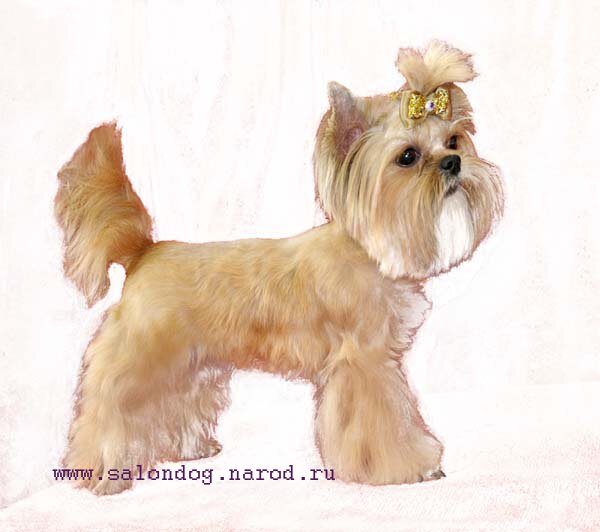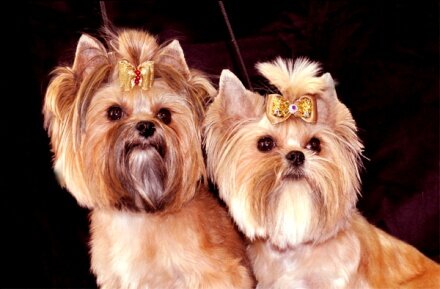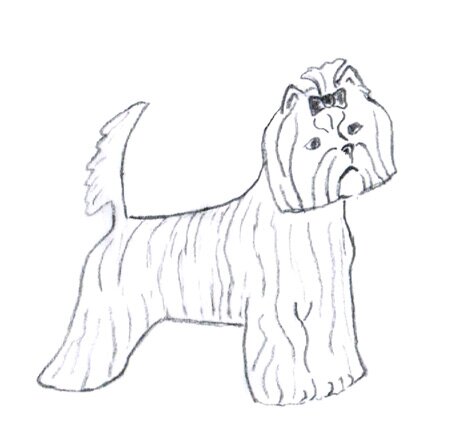THE BREED STANDARD THE RUSSIAN SALON DOG
APPROVED
by the Board of the Russian Kynological Federation
July 24, 2013
THE BREED STANDARD
THE RUSSIAN SALON DOG / RUSSKAYA SALONNAYA SOBAKA
The pictures below show the general appearance and the typical heads


Стойка собаки в шерсти Стойка собаки в стрижке

Translation: Dmitry Mamontov
Origin: Russia.
Date of publication of the official valid standard:
Approved by the Board of the Russian Kynological Federation on July 24, 2013.
Utilization: Companion dogs.
FCI classification: Group 9
Brief historical summary: The Russian Salon Dig is a toy breed created by the professional zootechnician
Ms. Yulia А. Lakatosh in the early 2000s in Moscow, Russia.
This breed is a result of multiple and thoroughly thought out complex crossings between various toy breeds.
General appearance: The Russian Salon Dog is a small, well balanced, proportionally
and firmly built dog of medium body length with a refined bone structure, dry muscles and sufficient substance.
The ears are carried erect, the skull is moderately rounded and the muzzle is not long.
Its abundant coat hanging straight and evenly down each side with a parting extending along the spine finishes up the overall chic appearance of the dog.
The color range is predominantly red.
Behavior/Temperament: Sociable, playful, good-tempered and affectionate companion dog.
Head: In good balance with the body, well-covered with long coat.
The beard and moustache are apparent. The skull should be also covered with long outer coat.
Skull: Rounded and not too wide, the upper part of the skull is moderately rounded and the forehead is rather high.
The superciliary arches are barely marked and the furrow on the skull is not prominent. The external occipital protuberance is hardly visible.
Stop: Pronounced and deep and may have a furrow not extending onto the skull.
Muzzle: The length of the muzzle is approximately 1/3 of the total length of the head.
Nose: Small, rounded, glossy and preferably of black color. Insignificantly lighter nose of brown or grey colors is allowed.
Either a flesh-colored nose or a winter-nose are both acceptable but not desirable.
Muzzle: Medium length and depth, not too long but not excessively short.
The muzzle is well-filled under the eyes and should never be either heavy or light. It moderately tapers towards the nose and is covered with long hair.
The nasal bridge, being approximately at the level of the lower eyelid, is straight and visible and has no any skin folds.
The under-jaw is well developed and its width is medium.
Lips: Tight and close fitting, not too fine. The color is black. Significant lightening of the pigment is acceptable but not desirable.
Uniformly solid pigmentation is not required.
Jaws/Teeth: Well developed jaws. The scissor bite. The pincer (level) bite is possible as well.
The undershot with tightly overlapping incisors without any clearance space is acceptable. With the advancing age,
the bite may change to tight undershot without clearance between incisors/ A distinct undershot is not sought after.
It is not acceptable when the lips do not completely cover the teeth of the lower jaw.
The complete bite with 6 incisors in both the upper and lower jaws is desirable but not obligatory. All 4 canines shall be in place.
The teeth are white and not large.
Cheeks (cheek bones): Rather flat.
Eyes: Medium sized, dark, shining, not too prominent, set straight forward and rather wide apart, oval in shape,
the rims of the eyelids are dark or harmonizing with the color of the coat. Close fitting eyelids. Light colored eyes are not desirable.
Ears: Prick ears carried erect, not too large, set high or at medium height on the skull.
The shape is close to an equilateral triangle. The tips are not rounded. The thickness of the skin is of medium thickness and firm to the touch.
The ears are uncropped, natural and coved with longer hair.
The hair shall be clipped short on the upper third part of the ear to make the shape of the tips visible and give a clean and neat look to the dog.
Neck: Dry, rather long, carried high and proud, sloping gracefully into shoulders. The nape is moderately arched.
The throat has neither dewlap nor folds. The length of the neck is approximately 1/3 of the length of the body.
Body: Compact as far as possibly, well developed, the length slightly exceeds the t height at withers.
The body should not be excessively elongated. .
Topline: Level, entire and uninterrupted, forming a fine and flawless line.
The distance between the withers and the croup should not be long.
Withers: Sufficiently pronounced, slightly above the line of the back.
Back: Straight, firm and fairly muscled.
Loin: Compact, slightly pronounced, moderately wide and fairly muscled.
Croup: Rounded, wide, slightly inclined and rather long. The rump has a slight slope towards the base oа the tale.
The points of the buttock are well defined.
Chest: Well developed, oval-shaped, the prothorax is well defined, the floating ribs are well-rounded and long, the chest is rather deep.
Underline and belly: The belly is sufficiently tucked up with thin and not loose skin.
Tail: Set either moderately high or high, covered with long coat and sickle shaped.
When the dog is in action or stands free the tail may be carried above the topline or over the back.
The tail can also be in repose and carried below the topline when the dog is moving.
Docking is allowed and in this case at least 2/3 of the tail shall be left. Natural undocked tail may be curved.
LIMBS: The length is medium to allow the dog look neither high on legs nor too stocky and low set.
FOREQUARTERS:
General appearance: Seen from the front and in profile, rather straight and upright, parallel and standing not too wide apart.
Shoulder: Rather well laid back, with fairly flat muscles. Not short.
Upper arm: Medium length. Moderately sloping.
Elbow: Pointed backwards.
Forearm: When viewed from the front, preferably straight.
Metacarpus (carpal joint): Well developed.
Pasterns: Firm, moderately inclined. Parallel set of the pasterns is desirable.
Fore and hind feet: Oval in shape, not large. The toes are rather tight.
The pigmentation of nails and pads is dark, or corresponds to the color of coat, or flesh colored if there is white spotting in the coat color.
HINDQUARTERS:
General appearance: In balance with forequarters. Parallel when viewed from behind. Moderately angulated.
Upper thigh: Slightly inclined. Hip joints are strong and well developed.
Stifle (knee joint): Moderate.
Lower thigh: Medium length, approximately equal to the length of the upper thigh.
Hock joint: Dry, well delineated and developed.
Metatarsus (rear pastern): The length is moderate. Standing upright when viewed from behind.
GAIT/MOVEMENT: Light, free, with rather long and straight-line steps when the dog is trotting.
SKIN: Elastic, firm, without folds. The pigmentation of any color is allowed.
COAT: In natural condition the coat is as long as possible, straight or almost straight, evenly covers the whole body, head and legs.
The coat is parting along the spine and hanging down each side of the body. Rather soft, glossy, its volume is moderate,
with small amount of undercoat, hiding natural outlines of the profile. Overall grooming or clipping is needed for shows (see the comments below).
Color: Solid. The red color range is preferred (solid red, cognac, light red, wheaten, golden, fawn). Cream.
Clear, intense and even colors are preferred. There can be a darker-colored mask on the muzzle.
No preference should be given between the specimen with and without mask when judging in the show ring.
Dark hairs may be present on the tail. The presence of single hairs lighter or darker than the main color
on the body is permissible but not sought after.
The sable color when the ends of the outer coat have some darker shading is allowed but not encouraged.
Young dogs until the age of 1.5 years may have more darker hairs than adults.
The pigmentation of hair may be darker closer to the roots.
Bicolor: Red-and-white and white-and-red colors of coat. White spotting on predominant red ground color may be of different shape and size.
Red in bicolored dogs corresponds to the colors described above in the solid range of colors.
Red color is preferred in the areas of eyes and ears.
SIZE AND WEIGHT:
Height at withers: 18-28 cm.
Weight: 1.8-3,5 kg. The weight should correspond to the overall size. 500 g more than the standard weight is allowed. .
FAULTS: Any departure from the foregoing points should be considered a fault and the seriousness
with which the fault should be regarded should be in exact proportion to its degree.
SEVERE FAULTS: Rounded, excessively protruding or narrow set eyes. Insufficiently strong cartilage of the auricle.
A gap between incisors with the undershot bite. Crooked or too short forearms. Excessive length of legs (legginess).
Excessively sloping croup. Excessive or insufficient weight.
DISQUALIFYING FAULTS: Cryptorchism, aggressive or overly shy behavior. Absence of furnishing coat on the muzzle, harsh or coarse coat.
Low set, drooping ears. Coat colors not described in the standard.
N.B.: Male animals should have two apparently normal testicles fully descended into the scrotum.
* Coat clipping and grooming are allowed.
The variants of the show clip: .
1. General grooming: the coat is evenly clipped on the head and over the body, including feet and the base of the tail.
The furnishing coat, which forms so called skirt, is shortened in such a way that the skirt does not impede the movement
but at same time the maximum possible length should be left. The upper third part of the ear is clipped short.
The foretop hair is fixed with a bow.
2. “Carre”, or the blunt bob: the coat over the body is shortened on the level of or slightly below the chest.
The foretop hair is fixed with a bow. The beard and moustache are clipped along the horizontal line at the level of the neck.
The coat on legs, neck and tail is slightly and neatly cut as well.
3. The “sporting” haircut: The body, neck, hips and shoulders are clipped short. The foretop hair is fixed with a bow.
The coat on the head is cut in the “Carre” style or in a form of a ball. The column-like shape is given to the coat on legs.
The toes may be trimmed short. The short coat over the body is blended to the longer coat on the limbs.
The shape of a plume should be given to the coat on the tail.



